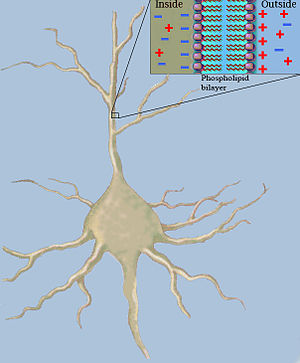
Back Teoria del cable Catalan Kabeltheorie German Teoría cable Spanish Kaabliteooria Estonian Teoria cablului Romanian Кабельная теория дендритов Russian Kablo teorisi Turkish Кабельна теорія дендритів Ukrainian

In neuroscience, classical cable theory uses mathematical models to calculate the electric current (and accompanying voltage) along passive[a] neurites, particularly the dendrites that receive synaptic inputs at different sites and times. Estimates are made by modeling dendrites and axons as cylinders composed of segments with capacitances and resistances combined in parallel (see Fig. 1). The capacitance of a neuronal fiber comes about because electrostatic forces are acting through the very thin lipid bilayer (see Figure 2). The resistance in series along the fiber is due to the axoplasm's significant resistance to movement of electric charge.

Cite error: There are <ref group=lower-alpha> tags or {{efn}} templates on this page, but the references will not show without a {{reflist|group=lower-alpha}} template or {{notelist}} template (see the help page).
© MMXXIII Rich X Search. We shall prevail. All rights reserved. Rich X Search


